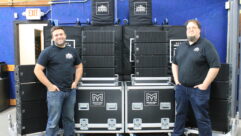
Audio for Multi-use Auditorium, Part 1
Sep 10, 2013 3:32 PM,
With Bennett Liles

Listen to the Podcasts
|
Editor’s note: For your convenience, this transcription of the podcast includes timestamps. If you are listening to the podcast and reading its accompanying transcription, you can use the timestamps to jump to any part of the audio podcast by simply dragging the slider on the podcast to the time indicated in the transcription.

Schofield Hall
When Schofield Hall on the campus of the University of Wisconsin got a total renovation, Audio Architects of Chippewa Falls was called in to outfit the place with Renkus-Heinz Iconyx IC Live arrays. Nancy Carlson and Andy Pierson are here to tell us the whole story on how it all went in and checked out. That’s coming right up on the SVC Podcast.
SVC: Nancy and Pierson:, it’s great to have you with us on the SVC Podcast from Audio Architects in Chippewa Falls, Wis. We have an installation project to talk about in Schofield Hall at the University of Wisconsin, but before we get into that, let’s have a verbal business card; tell us something about Audio Architects. What kind of an outfit do you have there?
Andy Pierson: Thanks for having us. We’re primarily a school, church, and government sound and video contractor, and recently we’ve just been experiencing an awful lot of growth in our school market. That’s both the K-12, additionally the higher education market. We’ve been extraordinarily busy, particularly this summer, and it’s prompted us to look into getting a new building to accommodate all the influx of materials that we have, so we’re looking to expand to a larger building in October. [Timestamp: 1:42]
Well I hope you get it done before winter really sets in. I’m down here in Atlanta and I don’t know how you guys do it up there in winter. I’d go reptilian and not even be able to move.
Nancy Carlson: Lots of layers, that’s the key.
All right, well let’s talk about Schofield Hall. That’s on the University of Wisconsin campus?
Pierson: Correct. The University of Wisconsin-Eau Claire.
What do they do with this place? It looks like it’s mainly lectures and so forth, but maybe they have some music acts in there, too. How big is the place?
Pierson: That’s correct. So it’s a 600-plus seat auditorium. It’s roughly about 60ft. by 70ft. in size. It’s used not only for forums, as you mentioned—that includes like the Chancellor’s meetings–they use it as a technology classroom. It’s also used as part of their orientation for all their new students, and it also is a venue for a number of musical activities. It’s used for small music groups, basically. It’s a great facility and part of the upgrade for that room specifically was to improve on the musical performance of the venue. [Timestamp: 2:47]
Okay, so they can handle live music, but I guess their main thing is visiting lecturers and speeches. It would seem that intelligibility would be a prime objective with the new sound system.
Pierson: Absolutely. Intelligibility is usually our first goal and then secondary toward that is to make sure we’ve got the music performance behind it. [Timestamp: 3:05]
Audio for Multi-use Auditorium, Part 1
Sep 10, 2013 3:32 PM,
With Bennett Liles

To match the aesthetics of the room, there’s a column on either side of the stage right on the proscenium, which hide the Renkus-Heinz Iconyx IC Live arrays speakers.
How are the acoustics in Schofield Hall? Was there any sort of acoustical treatment done as part of the upgrade? How much did the building itself have to be brought up to speed for this?
Carlson: It was actually part of a larger construction project. They did a full remodel of the stage where they actually took it all down to a concrete floor and just bare walls. There’s new carpet, new seats. They did quite a few acoustical panels along all of the walls and the front and everything. It was an OK space beforehand, but once they took the carpet out, it was pretty atrocious, I will say. I’m happy that they put carpet back in. But it did definitely need some of the new panels around the walls and they did the front of the balcony face as well. [Timestamp: 3:47]
Oh, well, that’s great that they did all of that and you didn’t have to come into a place that was going to be difficult to outfit with the new sound gear. Then you knew the whole acoustic situation, what it was going to be, from the start. And I think you used the Renkus-Heinz Iconyx IC Live arrays. Why did you choose those for this one?
Pierson: Ah, well, first of all they were one of the few steerable arrays that were out there that could handle the music performance. They could handle the sound pressure level. And we used those speakers particularly on this project because as we gave this a basic facelift, they wanted to maintain a lot of this historic look to it, since this is housed in essentially their main old building. With the Iconyx we were able to use the steering capabilities of it to get underneath the low balcony as well as hit the upper balcony part and hide the speakers, and all doing that while still maintaining the capability of having full rock and roll music output. [Timestamp: 4:46]
And obviously there are changes in the parameters to be made between optimizing the system for a speaking situation and having it tweaked for a live music performance, so I figure one feature of the system is the ability to have various parameter presets available and then dial up the one that you need for the specific event.
Pierson: For the most part, yes. So the main system, at least when it fires up, it’s controlled by a third-party control—controlled using Crestron—so there are a number of microphones that are just automated for general speech application. That also includes a lot of the audio content, any video sourcing that they’d be playing in the room. And then in addition to that, they’re able to plug in a 48-channel Yamaha M7 mixing console to the system, so then they have full control and full rock and roll performance. [Timestamp: 5:31]
And I guess they do that mainly for the music acts? Pierson: Correct or sometimes if they have a really high-profile event and they want to make sure and monitor it and then have a student control it. That can also happen with like a large board forum or maybe we’re talking about eight to 10 to 12 wireless microphones. [Timestamp: 7:39]
Yeah, I guess if they have a whole group of people wearing lapel mics in a free-form discussion format it could get a little dicey as far as the gain before feedback.
Pierson: Correct. And of course, as you know, sometimes when they’re doing these type of forums that in order to add some intimacy kind of to it, instead of standing on the stage, they’ll be right out on the floor in front of the speakers adding an additional challenge. So yes, 12 lapels in front of the speaker columns always makes it a little more challenging, but we’re happy to say that we were able to achieve good results with it; I think partly due to using a line array—the positive effects of that—but also then putting it into more of a manual control mode for something that would require more control. [Timestamp: 6:35] And did you use some column units on each side of the stage for this project? Pierson: Correct. So there’s the IC live triples and there’s a column on either side of the stage right on the proscenium, which in order to add to the aesthetics of the room and hide the speakers, they built columns to house these speakers in that you can see in any of the pictures that are published on it. Those columns weren’t originally in, but they built them in a way to match the existing columns in the room; so there were columns on the sidewalls. And so these actually added a nice aesthetical feature as well as hiding the speakers. [Timestamp: 7:10]
Yeah, I suppose they didn’t want them to look like speakers or they wanted them to blend in with the architecture where they didn’t call attention to themselves.
Correct.
And they’ve got a software application. I think that’s a Windows program called BeamWare?
Pierson: Yes BeamWare. That’s their proprietary software that is used just primarily in the setup of the speakers during the installation process because these were still so new. Ralph Heinz actually stopped out to commission the system, which was really quite unique and gave us the nice opportunity for hands-on training of the software for it. The software program works very easily. You can use it in more of an automated mode and then you can come in and fine tune it as well. [Timestamp: 7:51]
That’s what I call service when the guy with the company name actually shows up onsite to take you through the setup on the system himself.
Pierson: Absolutely, and you have a lot of trust when the gentleman’s name is on the box.
So what all have you got for audio sources on the inputs? You’ve got mics out there and can you go direct with band instruments and things?
Pierson: Absolutely. The system is set up with a number of channels, and those range from a number of analog inputs that are converting using the EtherSound snake, then it’s actually converted to a CobraNet that makes it into the speakers. So the speakers are connected to the system via CobraNet as far as their signal path, but it also means that we can add CobraNet inputs or outputs, we can add EtherSound snakes and we have a slew of analog inputs oriented all around the stage. So you name it, it’s got it. [Timestamp: 8:43]
Okay, well it sounds like you’ve got it set up to handle anything they can throw at you at Schofield Hall and I appreciate your telling us the story on it. In part two we’ll get into the subwoofer installation and talk about the video side of it with the big video wall you set up for them. Nancy Carlson and Andy Pierson from Audio Architects in Chippewa Falls, Wis. We’ll see you then.
Excellent.










